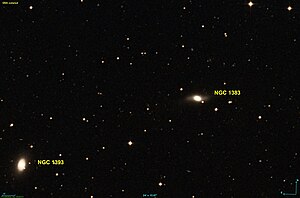NGC 1383
| Galaxy NGC 1383 |
|
|---|---|

|
|
| AladinLite | |
| Constellation | Eridanus |
|
Position equinox : J2000.0 , epoch : J2000.0 |
|
| Right ascension | 03 h 37 m 39.2 s |
| declination | -18 ° 20 ′ 22 ″ |
| Appearance | |
| Morphological type | SAB (s) 0 |
| Brightness (visual) | 12.5 mag |
| Brightness (B-band) | 13.5 likes |
| Angular expansion | 1.9 ′ × 0.8 ′ |
| Position angle | 91 ° |
| Surface brightness | 12.9 mag / arcmin² |
| Physical data | |
| Affiliation | LGG 99 |
| Redshift | 0.006498 +/- 0.000063 |
| Radial velocity | 1948 +/- 19 km / s |
|
Stroke distance v rad / H 0 |
(83 ± 6) · 10 6 ly (25.6 ± 1.8) Mpc |
| history | |
| discovery | John Herschel |
| Discovery date | December 11, 1835 |
| Catalog names | |
| NGC 1383 • PGC 13377 • ESO 548-053 • MCG -03-10-015 • 2MASX 03373925-1820220 • SGC 033523-1830.1 • LDCE 251 NED027 | |
NGC 1383 is a lenticular galaxy of the Hubble type SB0 in the constellation Eridanus in the southern sky . It is estimated to be 83 million light years from the Milky Way and approximately 45,000 light years in diameter. Together with NGC 1393 and PGC 13582 , it forms the NGC 1393 group .
The galaxies NGC 1391 , NGC 1394 , NGC 1402 are located in the same area of the sky .
The object was discovered on December 11, 1835 by the astronomer John Herschel and later listed in the New General Catalog by Johann Dreyer .
